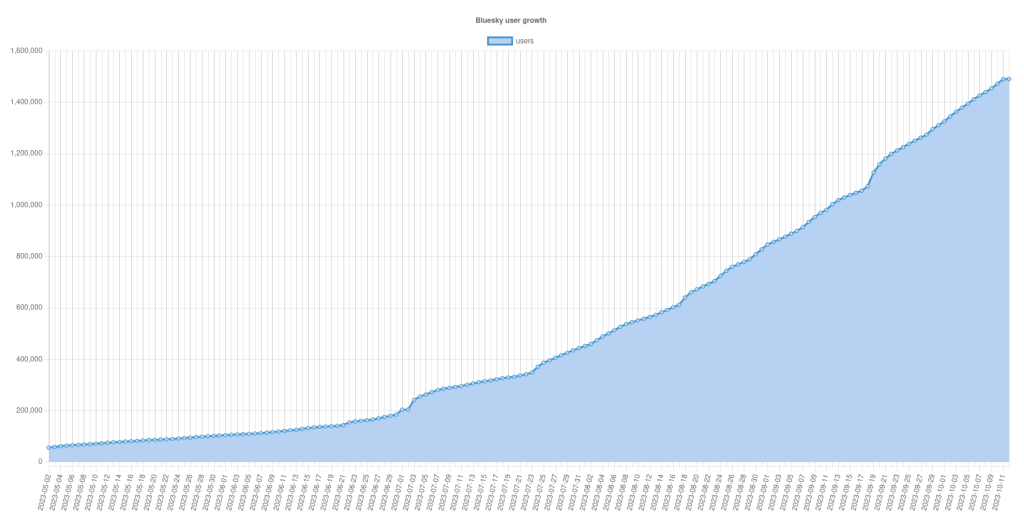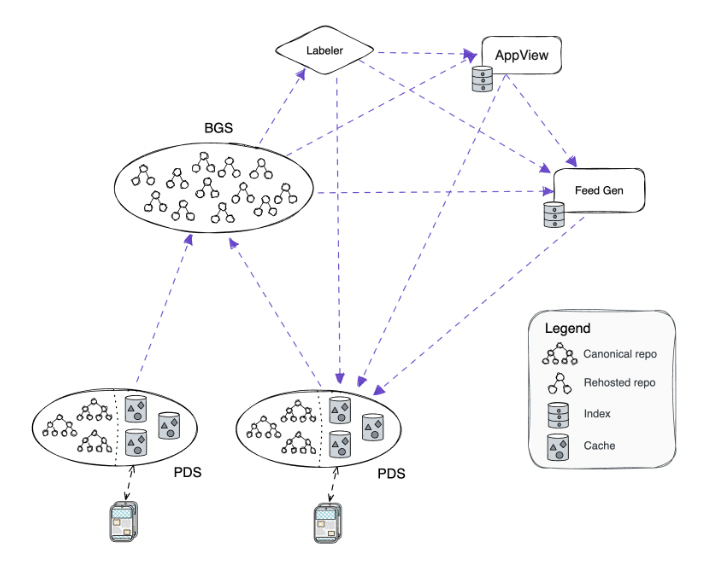Bluesky, the decentralized Twitter spin-off championed by Jack Dorsey, continues to surge in users as the team inches toward federation.
Bluesky Continues Rapid Growth, Reaches Federation Milestone
From September 2023 onward, we’ve seen a significant period of growth and expansion for Bluesky and the ATproto network, in a variety of ways. On September 12, the network hit a milestone of one million registered accounts on the service. Bluesky has managed to grow consistently since it started in January of this year. In the past month, growth has averaged a little over 1% every day.
User Growth Over Time
As with all other microblogging platforms, Bluesky sees a significant influx every time something happens at X. Mid September Bluesky hit a new record of over 50k new accounts in a single day, after news came out that Elon Musk floated the idea of charging everyone to use X. This amounts to roughly three times the average daily signups.

Measuring account growth for Bluesky’s network over time reflects how consistent the growth really is. Sure, there’s fluctuations, but the size of the network consistently grows by about 1% on a daily basis. The larger the network is, the bigger that number is in absolute terms: After Bluesky reached 1 million accounts, the network added another 400,000 users over the following four weeks.

Beyond user statistics, several large US media outlets on Bluesky have now used their domain names for account validation. In Bluesky’s world, accounts can set their handles to domain names to establish identity, provided that the account holder also owns the domain. The New York Times, the Washington Post and Bloomberg are all examples of Bluesky accounts who have recently done this. Another notable organization is the German Ministry of Foreign Affairs, who received international media attention for a public argument with Elon Musk on X, prior to migrating to Bluesky.
Dealing with Growth
The other side of the coin is that Bluesky’s current infrastructure is starting to hit its limits. Over the next few months they will be working on upgrading their back-end to a new version (dubbed simply v2), that can handle over 10 million accounts. Bluesky engineer Jake Gold recently announced a major milestone in work on v2, which is also a major milestone on the work towards federation.
This post is traversing PDS -> BGS -> AppView instead of the old path PDS -> AppView…This took significant work…[and is a] big milestone in the v2 scaling effort because it enables multiple Bluesky PDS instances!Jake gold
As there now seems to be momentum in the move towards Bluesky, Gold mentioned that they want to speed up the current growth by 10x ‘ASAP’. One of the ways they want to accomplish this from a technical perspective is by slowly starting the federation process, but limit it to other servers (PDS) that are also run by Bluesky.

The Bluesky team also provided an update on federation support. With the latest update, the entire system is now working to the team’s design plans. Federation is now possible, but not yet enabled. The team reiterated that the network could technically start federation right now, but that they intend to finish implementation details and security work. The team expects a basic version of federation to be available in the coming weeks, but initially will only allow federation with other servers (PDS) run by Bluesky.
Treading Water
Bluesky has been criticised for its casual approach to Trust & Safety. One concern is that the team has yet to appoint an official role to someone to fill that purpose. Speeding up network growth by a factor of 10 without addressing this seems risky. A startup building a network from scratch has a golden opportunity to start from first principles – Trust & Safety is a big one.
This thread provides a good example of how the shared understanding of the space is currently muddled. There don’t seem to be clear answers to how the network should deal with a server (PDS) that either contains bad actors, sock puppet accounts conducting astroturf campaigns, or other attempts to influence algorithmic feeds.
There are hard questions that deserve careful deliberation. And that careful deliberation seems hard to square with the team’s goal of expanding growth by 10x ASAP.
Inside Twitter rival Bluesky’s first major crisis, as investors pressured CEO Jay Graber to speak out about racist incident
Bluesky, the Twitter rival, faced a crisis when a racist username went unchecked, leading investors and users to push for an apology that took the CEO 10 days to formulate.Kylie Robison (Fortune)
